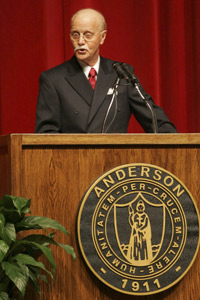Anderson University celebrated two milestones during Founders Day festivities on Feb. 7. The occasion marked the 95th year since the institution’s founding and the first convocation as Anderson University.
 Speaker – Paul Talmadge, former academic dean at Anderson, delivers the keynote address at the school’s first Founders Day since moving to university status.
Speaker – Paul Talmadge, former academic dean at Anderson, delivers the keynote address at the school’s first Founders Day since moving to university status.Paul Talmadge, who most recently was program coordinator of the Billy Graham Training Center in Asheville, served Anderson as vice president and academic dean for nearly 20 years (1969-1988), before becoming president of North Greenville University, delivered the keynote address. In his remarks, Talmadge praised Anderson University for remaining true to its Baptist heritage despite the departure of other historically Christian institutions from their founding missions.
“This institution, unlike many colleges originally founded as Christian institutions but now completely independent, has focused on its role of serving students and the community, rather than struggling to be free from those who nurtured it through the years,” Talmadge told the audience.
Talmadge, who helped see Anderson through some tumultuous times during his tenure, acknowledged that for much of its history, Anderson was focused on survival, but he quickly added that those days are now long gone as the institution has a new emphasis, not on survival, but on “significance and service in a challenging age.”
Indeed, the past year has been one of the most significant in the history of the 95-year-old institution. Not only did it make the transition this year to university status, but it also successfully launched its first graduate studies program, gained the prestigious top-tier status among colleges and universities in the South (U.S. News and World Report), and launched the single biggest building project in Anderson’s history. This fall, students and faculty will enjoy a new $7.5 million, 45,000-square-foot library that is currently under construction.
While Talmadge praised his former employer for its health, academic excellence and emerging leadership role among private universities in the South, he saved his highest praise for the way Anderson has regained a focus on service to humanity through the cross, which is emblazoned on the university seal.
“The school that once prided itself in being isolated in a respected part of town now sends students into the most needy neighborhoods,” he said. “Each freshman completes 20 hours of community service. Some majors have a community service component. Each student organization is expected to have a community service project. The call to selflessness that began to echo in these halls long ago has at last been learned. Ancient voices find again the words, ‘Well done, good and faithful servants.'”